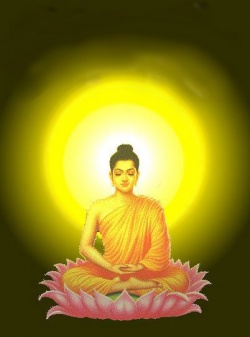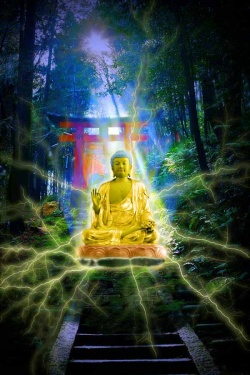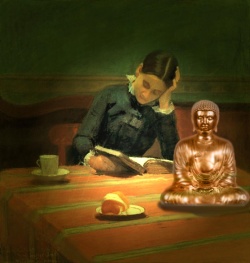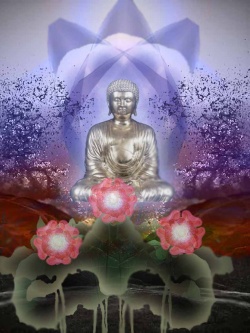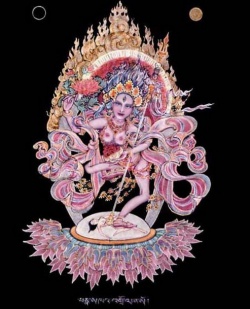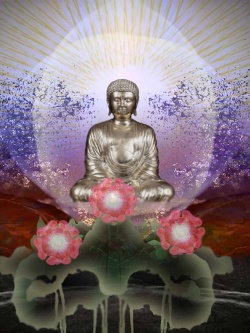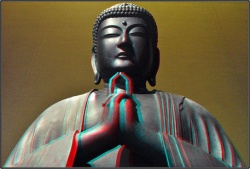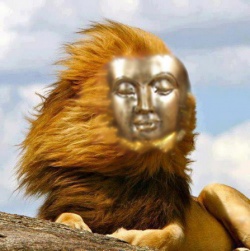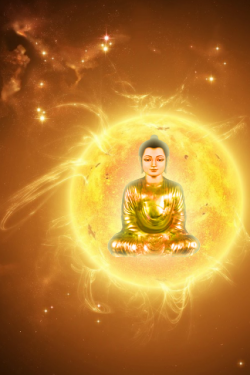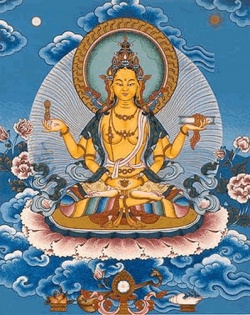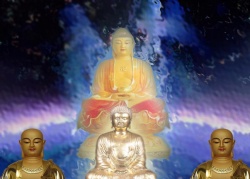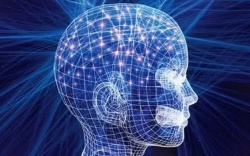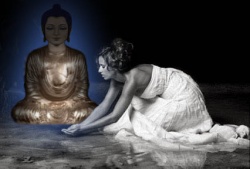The Epistemology of Buddhism
by Douglas M. Burns
First Published 1963
The world abounds with a myriad of conflicting ideologies; each claiming the truth; each refuting the others. Dialectical materialism and Protestant theism, Roman Catholicism and pagan polytheism, spiritualism and atheism, Freudianism and Vedanta; the list is virtually endless.
One approach which the 'seeker of truth can and must use in his investigation of each philosophical system is to ask the question: "How do you know?" or otherwise stated: "Why do you believe? What is the evidence? How can you be sure? Is there possibly another explanation?" This is the study known as epistemology, the study of t-he acquisition and verification of knowledge.
Human beings are much too credulous. The vast majority of us believe either what. we want to believe. or what we have been told to believe. It is a rare person who thoroughly and honestly explores the question: "How do I know?"
One of the greatest appeals of Buddhism for the Western mind is that the Buddha repeatedly told his followers to base their convictions neither on faith nor on scripture. 'Investigate. analyze and see for yourself ' he told them; then you can believe. However the unfortunate paradox is that most Buddhists unquestioningly accept the writings of the Tipitaka for no other reason than the alleged authority of the Buddha. Buddhism is in no way exempt from the demand for epistemologica analysis. The true Buddhist is one who critically and impartially examines the teachings of the Buddha, and asks himself: "How do i know it. is true?" Such is purpose of this writing.
I should like to divide epistemology into two major categories, logic and mysticism. [1]. By 'Logic' I refer to `the analytlcal, inductive and deductive reasoning processes employed by science and mathematics. Scientific knowledge is based upon sense perception experience. Through the mediums of sight, sound, touch, taste and smell the scientist, aided by instruments, explores the physical universe. His observations are recorded and made known to other scientists. Once a given amount of data has been accumulated logic or reasoning is employed to explain these observed phenomena on the basis of some theory which is consistent with the recorded observations. Science is objective and analytical. It wishes to take nothing on faith and shuns metaphysical speculations.
By mysticism I refer to all forms of knowledge which are acquired by means other than logic and sense perception. Faith, intuition, clairvoyance and prophetic visions would all be included in this category.
The Buddhist World View
We shall employ first logic and then mysticism in an attempt to determine the validity of the three basic tenets of the Buddhist world view. These three are Nirvana, Karma and Rebirth.
The Buddha described Nirvana as a changeless dimension of existence beyond sense perception experience. It is neither matter nor energy and does not exist within space and time. It is a level of reality totally unrelated to mundane human experience and the laws of physical and mental phenomena. Nirvana is timeless, changeless, indivisible and not compounded. The Buddha did not describe it by such terms as Cosmic Consciousness, Ultimate Reality or Universal Mind [2].
Karma is a natural and universal law of moral or psychological cause and effect. Certain states of mind are regarded as causes which have other states of mind as their effects. As a result of the law of Karma the person whose mind is occupied with thoughts of greed, hatred or egotism will later experience sorrow, fear, worry, or some other unpleasant state of mind. Love, kindness and compassion produce happiness and emotional well-being while neutral states of mind have effects which are neither pleasant nor unpleasant. It depends on his actions or Karma, whether his destiny will lead him up or down, either to happiness or to misery. [3]. However, the Buddha also stated that not all pleasure and pain is the result of one's karma [4].
Since karma may act over considerable periods of time, a person may die before all of his karma is fulfilled. In such a case the unfulfilled karma will express itself in a future rebirth. Persons born into an unhappy environment are believed to be paying for their misdeeds of a previous incarnation. All this is due to natural laws of cause and effect and not the judgment of God.
Logic
In this section we shall confine ourselves to logic and try to determine if the powers of human reasoning can establish the existence or non-existence of Nirvana, karma and rebirth.
Nirvana
How can we logically prove the existence of Nirvana? The answer is that we cannot. It is improvable by the nature of its own definition. Logical proof requires the use of human reasoning and our reasoning powers are confined to the realm of human knowledge and understanding. Our knowledge and understanding are based upon previous experiences, either emotional or sensory. But Nirvana is neither a mood nor an emotion, and it does not exist within this sense perception realm of space, time and matter. Thus it is beyond the realm of normal human experience, which means that it is beyond logical proof. if it could be proved logically, it would not be Nirvana.
Karma
Can we prove the existence of Karma? Unlike Nirvana, it is said to be an inherent part of our everyday life. But despite its alleged ubiquity, I feel that karma too is unprovable though for a different reason. The chief difficulty with investigating the existence of karma is that it is too elusive. Karma is intangible, immeasurable and variable in its manifestations. There is no way of predicting when or how it will operate. Sometimes the effect may immediately follow the cause; sometimes there may be a delay of decades or even centuries. How can we be certain that a given instance of sorrow is the karmic result of a specified act of selfishness? We cannot.
Unlike physical, chemical and biological laws, moral law cannot be controlled in laboratory experiments; life itself is the only laboratory. Furthermore, we are rarely certain of another person's true motivations, In fact we usually are not fully conscious of our own motivations, whether they be good or evil. The same can be said about feelings which are the karmic results of motivations. We are rarely certain of the degree to which another person is experiencing happiness or sorrowp especially when life is so subtly mixed with both. Likewise we are often unaware or unwilling to admit our own frustrations, fears and anxieties. And finally it must be noted that there are no units by which we.can measure or quantify desires and feelings.
So again, the point is that Karma is too subtle and too elusive to be proved as a demonstrable, scientific fact. Sighting isolated examples of evil doors who later experience dukkha or sorrow is not proof of karma. Isolated cases do not necessarily represent a general rule or reflect the workings of some natural law. In fact, one might record individual life histories in an endeavour to refute the law of Karma.
Often it is stated: "Karma must be real or there would be no justice in the universe." Such a statement rests upon the assumption that there is Justice in the universe. The reply is: "How do you know there is any such justice? Perhaps there is none." We must beware of believing simply because our belief provides solace. A counter reply often is: "! know there is justice. I feel it so strongly that I don't need proof." This is an argument based upon feelings or intuition, which we shall examine presently. For the time being we are concerned with logic.
Rebirth
Now we come to an interesting paradox Many educated Westerners (liberal Christians, agnostics and atheists are quite receptive to the idea of karma. This is especially true if such a concept is presented to them by the term "moral law" without any Oriental connotations. These same people will usually take a very sceptical view of rebirth. Yet if we examine the matter objectively, we will note that while there is virtually no evidence to support the concept of karma, but we do find some evidence to support the theory of rebirth.
Among scientists today, the most widely accepted view of the human mind is that all thoughts, feelings and behaviour result from the neurophysiological activities of the brain. That is, the human psyche is nothing more than the biochemical activities of a highly evolved nervous system. As distasteful as such a view may be, we must have the courage to acknowledge that much evidence has been accumulated in support of this theory. For example, it is possible to produce mechanically deep sleep, dreamlike consciousness or alert awareness, or to produce fear, anger and other emotions or to recall memories vividly all by electrical stimulation of the brain. The results are determined by the anatomical area which is stimulated and by the amount of voltage used. [5]
If such a theory can account for all mental phenomena, then the existence of rebirth becomes extremely unlikely. Two facts should be noted. First, science is still a long way from understanding the origins of memory and consciousness. Second, there are mental phenomena which virtually defy a mechanistic explanation; these are the phenomena of psychical research - telepathy, clairvoyance, precognition and psychokinensis. Though parapsychology is a very controversial topic among scientists, and though considerable fraud and careless investigation have been conducted under the label of psychical research, the evidence for telepathy and precognition virtually defies refutation. [6] Thus we have good reason to believe that there may be a non-physical aspect of the human mind. And if there is a non-physical aspect of the psyche, why could it not continue to exist after the physical portion of the personality ceases to function? That is why could it not live beyond death?
So far we have only speculated as to the possibility of postmortem survival. This in itself is not evidence for rebirth. The evidence wlhich does support this theory is the apparent memories of past lives and the alleged verification of such memories. For convenience of discussion, I should like to divide such memories into three categories: (i) hypnotic age regressions, (ii) testimonies of normal adults who claim to recall past lives while in a State of waking consciousness, (iii) case histories of children who tell of past lives.
Psychologists and psychiatrists have long realized that a person's memory can be remarkably increased while under hypnosis. Often long-forgotten and trivial iinformation can be clearly remembered, such memories being inaccessible to the subject during normal waking consciousness. [7] Even experiences of early childhood can be vividly relived. [8] Depending in part upon the hypnotist's technique, many subjects will assume childish speech and mannerisms appropriate to the age to which they are regressed. However, because hypnotic subjects are very suggestible, the question arises as to whether or not all such alleged memories are true. In order to answer this question, two Yale researchers conducted an experiment and recorded the following:
"We have been working with a group of five easily hypnotized subjects, all of whom are capable of deep hypnosis with amnesia in which they are able to relive vividly past experiences. We find that all our subjects consistently and without exception are able to live out 'future' experiences when an age or date is suggested to them under hypnosis." [9]
Some of these so-called future experiences were 10 years in the future. The likelihood that all five are cases of precognition seems virtually nil, since precognition is a rare phenomenon under any circumstances and is not usually enhanced by hypnosis. [10]
The researchers concluded:
"We believe that each of our subjects, to please the hypnotist fantasized a future as actually here and now. We suggest that many descriptions of hypnotic regression also consist of confabulations and simulated behaviour."
The findings of other investigators support this conclusion. [11]
On the other hand, since hypnosis can produce phenomenal increases in one's powers of recollection, we are confronted-with the question of how often hypnotic age regressions represent true memories and how often they are only fantasies. Probably most cases represent varying degrees of both.
Numerous cases are on record of hypnotized persons being asked to go back in time and tell of their earliest memories. Instead of describing scenes from early infancy, some subjects have told of previous incarnations, perhaps during the time of the Egyptian Pharaohs or the Roman Empire or from some more recent era. [12] The great majority of such cases have come from persons who had no previous belief in reincarnation and no exceptional knowledge of ancient history. Yet many of these cases have been carefully examined and found to be historically accurate, even on obscure facts known only to a handful of historians. A few have not only related historically convincing past life histories, but have done so in the language of the time in which they claimed to have lived: When awakened from their hypnotic trance, they denied any knowledge of such a language. In some cases these have been little-known languages, such as ancient Egyptian or an early Norwegian dialect. [13]
Several of these alleged past lives have been so inaccurate historically there is little question that they represent either fraud or fantasy. However, such cases no more disprove rebirth than erroneous memories of one's present life disprove the existence of childhood,
Those who reject the theory of rebirth contend that the historically accurate information related in these alleged experiences have been in some way acquired in the subject's present life. Such knowledge may be consciously forgotten but retained subconsciously. Under the influence of hypnotic suggestion, this material is skillfully woven into a convincing account of a previous life. Support of this theory is noted by the fact that hypnosis often increases one's creative abilities. Persons with little literary talent have been known to compose poems of high quality quickly and skillfully at the suggestion of the hypnotist.
In an experiment conducted by Edwin S. Zolik of Marquette University, subjects were hypnotized and instructed to recall past lives. Several did so with considerable plausibility and when awakened, denied any knowledge of the information they had given while under hypnosis. The subjects were then dehypnotized an asked to recall the source of their information. They then told of novels, theatrical production or childhood contact from which their information was obtained. [14] We should not at this point that persons under hypnosis are usually alert to the expectation and desires of the hypnotists, whether such wishes are spoken or not. Thus alerted, they often try to comply with these wishes. This principle could apply either in furnishing false account of past lives, or in furnishing false accounts of how the information for a genuine past life was obtained.
Stevenson cites the following case recorded by another investigator:
"A young man while hypnotized began to talk in a strange language, eventually recognized as Oscan, a dialect of Italy in the third century B.C. The subject wrote out what he was saying, which proved to be an Oscan curse. Further investigation showed that the subject had sometime before day-dreamed in a library while his eyes rested on a grammar of Oscan which happened to be lying open on the table before him. Quite unconsciously he had absorbed the phrases of Oscan which he had read. Then subsequently in the hypnotic trance, these phrases reached expression, In his ordinary waking state the subject had no remembrance of the source of his information. [15]
Usually subjects who speak in archaic dialects do not claim to be recalling a past life and in a great majority of cases they speak only a few scattered phrases. The rare cases in which persons describe past lives while speaking fluently in a little-known language are more difficult to refute.
The whole problem centres on one principle: In order to prove that a person actually recalls a past life, we must prove that there is no other possible way by which such knowledge could have been obtained. This is virtually impossible, especially when some writers have postulated the acquisition of such knowledge by telepathy or clairvoyance! If a subject describes a life as an obscure personality in some remote part of the world, there will probably be no records by which we can verify the claim. If a person describes a life from a well-known historical era, then we can easily postulate some way in which either consciously or unconsciously acquired this information.
If a group of subjects were to be raised from the moment of birth in a rigidly restricted environment so as to control all of their contacts with the outside world, we could say with certainty that their accounts of past lives were not derived from novels, historical writings, radio programs or forgotten conversations. But such an experiment is contrary to the mores of a democratic society.
Occasionally, persons will recall episodes of previous lives without entering a trance and when fully aware of their environment. This is especially prone to happen during times of free association and meditation. I can speak from personal experience at this point. During the summer of 1960, 1 was tested for 20 hours as a subject in a series of five psychological experiments. The procedure involved the use of a dermohmeter, an instrument which measures changes in the electrical conductivity of the skin. Such changes occur with changes in one's emotional state. and often the instrument detects repressed material or other emotionally charged memories of which the subject is unconscious. The procedure is designed to bring these repressed or forgotten memoies into consciousness.
On entering the experiment, I had no expectations of recalling any previous existence, nor was rebirth in my mind. During the 20 hours, I recalled at least six "past lives" - one as a Malayan savage, one as a Buddhist monk, one as a Roman soldier, one as a Frenchman, one as a Bavarian farmer, and one as an American. They were all in the form of hazy visual experiences, not unlike the memories of my childhood during the age of four. I did not recall any non-English words nor any dialogues. Historically they seemed accurate., but what was most impressive was their emotional content. I not only remembered had happened, I also relived the experiences with varying degrees of feelings. In all but the American life I had considerations and emotional reactions very much unlike my present self. For example, as a Catholic Bavarian farmer, I felt guilty and concerned about having married a Lutheran girl.. During all this time, I was fully awake and in contact with my environment. But the point I wish to make is this: As convincing as these stories seemed to he, I have no certainty that the were anything more than fantasies. And I know of no way to establish their validity.
Perhaps the strongest evidence to support the theory of rebirth originates from the case histories of persons, usually children, who claim to remember the life immediately preceding their present one. In such cases the person can often tell his former name, the names of the former members of his family and the location ofprevious residence. Stevenson [16] has done an excellent job of recording 44 such cases - which allegedly received careful and critical study. In 26 of. these cases, six or more items of information were correctly matched between the claimed memories and the verified facts; the two families involved had no knowledge of each other and in most cases resided in different towns or countries. In at least 20 out of the 26 the memories first occurred in children under the age of 10, and in at least six instances, the children were three years of age or less.
Questions of fraud and careless investigation combined with a desire to results are naturally raised. Yet such accusations seem grossly inadequate to account for all of these cases. In interpreting those data Dr Stevenson who is the Chairman of the Department of Neurology and Psychiatry at the University of Virginia School of Medicine, makes the following conclusion:
"I will. say, therefore, that I think reincarnation the most plausible hypothesis for understanding the cases of this series. That is not to say that I think they prove reincarnation either singly or together. Indeed, I am quite sure they do not. But for each of the alternative hypotheses I find objections or shortcomings which make them for me unsuitable explanations of all the cases, although they may apply to some
The evidence I have assembled and reviewed does not warrant any firm conclusion about reincarnation. But does justify, I believe, a much more extensive and more sympathetic study of hypothesis than it has hitherto received in the West. Further investigation of apparent memories of former incarnations may well establish reincarnation as the most probable explanation of these experiences."
I fully agree with Dr. Stevenson's conclusions. The evidence at hand strongly suggests that rebirth is a fact, but as yet this evidence is inconclusive. Also, even -if we wore to prove rebirth then this in itself would not prove either Karma or Nirvana.
It is often asked if the theory of rebirth is not disproved by the fact that the world's population is steadily increasing. Three possibilities, either singly or together, can make rebirth possible in the presence of an increasing population. First, several schools of thought hold that spiritual evolution accompanies biological evolution. After,developing through various stages,of. animal existenceg a soul or bhavanga-sota is finally ready for human embodiment. Once a human, it remains a human, and becomes a more spiritually and mentally advanced person with each succeeding incarnation. Considering this hypothesis, we should note that the animal population is steadily decreasing as the human population increases. Second, both Buddhists and Hindus teach that there are innumerable inhabited planets in the universe, and a person does not necessarily have to be reborn on the same planet in each life. Finally, some of the ancient texts mention a duration of several centuries elapsing between successive human embodiments. As the population increases, the interval between lives would be proportionally shortened.
The Limitations of Logic
From the Buddhist viewpoint we have now arrived at a most perplexing conclusion. The three major pillars of the Buddhist world view are either unprovable or unproved. But what is also imnortant is that they cannot be disproved. Nirvana cannot be disproved for the same reason that it cannot be proved. A similar statement can be made regarding karma. and rebirth we have already discussed.
Here Buddhism and mechanistic atheism come to their great stalemate; neither can disprove the other. But, if we look deeper into this matter, we will find that this is a problem which applies not just to Buddhism and atheism but to almost every philosophical system that man has devised. Despite three millenniums of inquiry and investigation on the part of philosophers, scientists and theologians, no man has ever proved that there is a God, and no one has ever proved that there is not a God. No one has ever proved life after deathy and no one has ever proved the contrary. No one has ever proved that the universe is just, and no one has ever proved it is not. In other words, we know very little about the most fundamental questions of man's existence.
At this point I shall temporarily digress from Buddhism, but in so doing I think the reader will have a deeper appreciation for our concluding statemonts on the Dhamma.
It is safe to assume that virtually every reader of this article believes in the atomic theory of matter; that is, that matter is composed of atoms. I would also venture to guess that over 95% of the readers base this belief on nothing more than faith. We have faith in what we read in text books, magazines and newspapers. Te have faith in what scientists tell us. But we are never really certain; we can only assume that they are speaking the truth. Only a scientifically educated minority can cite the numerous experiments and observations which support the atomic theory. put even the scientists themselves believe on faith, though on a more sophisticated level. A large number of diversified and sometimes costly experimental observations are required before one has adequate support of the atomic theory. It is doubtful if any one scientist has made all of these observations for himself; rather, scientists obtain most of their knowledge by studying the reports of one another's investigations. That is, they have faith in the accuracy of their colleague's claims. But, science is a human creation. As such it is not immune to errors, and scientific errors do occur.
Even if we exclude the possibility of errors, we cannot be 100% certain of the validity of a scientific discovery. Perhaps the classic example is the case of the Piltdown man. From 1911 to 1953 Piltdown man was regarded as a species of cave man whose fossil remains were uncovered in Sussex, England. He received mention in virtually every text on human evolution written prior to 1954. However in 1955 Piltdown man was discovered to be a hoax, perpetrated by someone for the probable purpose of gaining scientific fame. The bone fragments included a skull cap and a jaw bone and had been skilfully altered. The jaw was that of an ape, chemically treated to make it appear aged, while the skull cap was that of an American Indian. [17]
Another example, with which I am personally acquainted, is the case of a fellow medical student who was discovered falsifying the results of his research on kidney function shortly before presenting these "data" to the scientific world.
Perhaps the major weakness of scientific theories is that they are founded on inductive reasoning; that is, they are conclusions about the general scheme of nature based upon an accumulation of isolated observations. Let us take biological evolution as an example. No one has over seen evolution per se. It is not something that one can weigh or measure or photograph or isolate in a test tube. How then did Darwin arrive at his now widely accepted theory?
First he noted that all species of plants and animals are competing in a struggle for survival. The strong, healthy and efficient forms survive, while the weak and inefficient die out. Those that survive pass their advantageous characteristics to their progeny, He further observed that there is often no clear distinction between the various species and genera of plants and animals; instead of clearly defined species one sometimes finds a finely graded spectrum of sub-types which seem to bridge a gap between morphologically distinct groups. There are even primitive microorganisms which appear to be a compromise between plants and animals. He also noted that geographically isolated regions are often inhabited by species and genera found in no other part of the world. And finally, he noted that in fossil deposits are the bones of extinct animals which are primitive variations of existing species; the deeper or older the geological strata, the more primitive its fossils. Geologists had already come to believe that the world was several millions of years old. [18]
Did Charles Darwin prove evolution? Technically he did not. What he did was to say that by postulating the existence of an evolutionary process we can account for all of the above observations. In other words, the theory of evolution is consistent with nearly every datum acknowledged by geologists and biologists, and nobody has presented a better theory to account for the same facts. However, we have no guarantee, that some day a different and better theory will not be devised. Nor can we be certain that in the future scientists will not discover a large number of biological facts which defy an evolutionary explanation, thus throwing doubt on the Darwinian theory.
The popularity of a given theory increases in direct proportion to the number of facts it seems to account for and the number of phenomena it seems to explain. The more popular it becomes, the more reluctant men are to question or abandon it. Such was the case with the phologistan theory which was advocated by the chemists of the 18th century. It seemed to explain so much that few men questioned it. Yet eventually it was proved to be wrong. Scientists had been misled for nearly 100 years. [19]
I very much believe in the atomic theory of matter and in the theory of biological evolution. I would be very much surprised to discover evidence to the contrary. Yet~ while I may feel 98%, or oven 99.9% certain that these theories are correct. I can never be 100% certain. The point I wish to make is this: Certainty is relative rather than absolute . The truth of an theory must be viewed in terms of probability.
But what we have said so far applies only to inductive reasoning. What about deductive reasoning, the reasoning of mathematics, of arithmetic and geometry? Deductive reasoning rests upon our immediate perceptions of time, space and matter. These we regard as axioms as self-evident truths which never need to be questioned. Examples of deductive reasoning are: 3 + 3 = 6; parallel lines never meet; the shortest distance between two points is a straight line.
Another example is the familiar formula d = rt, or distance equals rate multiplied by time. If an automobile travels at a rate (r) of 30 miles an hour for a time (t) of two hours, then the distance (d) traveled is 60 miles, 60 = 30 X 2. This appears so obvious that no one would question it.
As a final example, lot us assume that an :.automobile is traveling along a highway at 45 miles an hour. Another automobile is travailing 50 miles an hour in the same direction and will pass the 45 mile-an-hour car. Relative to the slower car, the faster car is traveling at five miles an hour. 50 - 45= 5. It will take a few seconds for the faster car to pass the slower, and the occupants of both cars will be able to see clearly the faces of the occupants of the other. This is because they are moving at a rate of only five miles an hour relative to each other.
If, however, the two automobiles are traveling at these same speeds in opposite directions, their velocities relative to one another are 95 m.p.h. (50 + 45 = 95.) In this case it will take only a fraction of a second to pass each other, and the faces of the occupants in the other car will be blurred. Again this is obvious. It is common sense, and the reader may well wonder why we bother with such examples.
To answer this question, let us go back to the year 1887, when two scientists were measuring velocities of the same sort as we have just mentioned. But, in the place of the slower car they used the earth as it traveled through space. And in place of the faster car they used a beam of light, also travel ling through space, sometimes in the same direction as the earth and sometimes in the opposite direction. Let us arbitrarily assign to the, earth a velocity of one, and say that the speed of light is 100. It stands to reason - that a beam of light traveling in the same direction as the earth will take a longer time to cross the surface of our planet than one traveling in the opposite direction. Common sense tells us that the one overtaking earth will pass us at a relative speed of 99 (100 - 1)~ while the, other will have a relative velocity of 101 (100 + 1 ). However, this is not the case. The same experiment has since been repeated many times, with light beams from various sources In every case, the velocity of light relative to the earth has been the same, l00 + 1 = l00: 100 - 1 = 100: This contradicts the fundamentals of reason, and yet it is an observed fact.
With this discovery the scientific world was plunged into a most profound enigma, one which was not resolved until 1905. The man who unraveled this mystery earned himself the title of being one of the greatest geniuses of all time. He was Albert Einstein. [20]
By his theory of relativity~ Einstein has shown that our basic concepts of time, space and motion are erroneous. What appears to us as indisputable fact, is really an illusion, an illusion which is adequate for the problems of everyday life, but not for a true understanding of the universe. The formula d = rt is not quite accurate. In its place we must substitute more complex formula.
Other ramifications of Einstein's work challenge the validity of Euclidean geometry. Quite, possibly there is no such thing as a straight line; if we travel through space long enough in a given direction we may arrive at our starting point: [21] Perhaps the best example to assist one in appreciating 1 is by an illustration of now radically relativity changes our concept of time. Let us assume that a man enters a space ship and travels through space at 99.99% the speed of light. His journey lasts one year. At the end of that time he returns to earth. He has eaten about a year's supply of food and has a year's growth of beard. All the clocks on the space ship record the passage of one year's duration. He has aged one year and accomplished a year's amount of work. But on returning to earth he finds that 70 years have elapsed during his absence! While a year passed for him and his space ship, seven decades of history have taken place. [22] His wife and siblings are now deceased. His children and grandchildren are old men and women, yet he is in the pr,ime of life. While this may sound like science fiction, it is accepted by physicists as scientific fact, and this phenomenon of time slowing down has been produced in laboratory experiments. [23]
Thus we come to the conclusion that logic, both inductive and deductive is not an infallible means to truth. And yet, this conclusion itself is based upon logic. In other words, we have logically demonstrated the limitations of logic.
We cannot avoid reasoning. Conceptual thinking is an inherent aspect of normal human consciousness and the basis of all language. Man's ability to reason with concepts is perhaps the one feature which separates him from the lower life forms and has made him the dominant species on this planet,
Thus in concluding on logic, I will say that I believe it to be our best tool for the discovery of truth, but it is not an infallible tool. We must be aware of its limitations and imperfections.
MYSTICISM
The conclusions we have just reached may be startling and perplexing to the Occidental mentality but to the Hindus we have done nothing more than restate an old and long accepted doctrine. More than two centuries B.C. the Bhagavad Gita spoke the following:
"All creatures are led astray as soon as they are born by the delusion that this relative world is real. This delusion arises from their own desire and hatred." [24]
In Hindu thought the physical universe, this world of sense-perception existence, is not true reality. The true or absolute reality is Brahman, the Infinite Being, also spoken of as Cosmic Mind, Universal Consciousness and the Absolute. Both the physical universe and the human mind are but finite manifestations of this One Universal Mind, and our passionate concern for the physical world blinds us to this Ultimate Reality, which forms the basis of our consciousness. Thus, the yogi withdraws from the world of sense-perception in search of Absolute Truth. He sits with eyes closed in silent meditation. Hour after hour, day after day, year after year, he shuts out all discursive thoughts and sensory distractions. He concentrates only on union with Brahman, or at least on ascension into some higher plane of existence. Occasionally he will claim success, and relate, as much as words can relate, his experiences in the realms of spirit.
But one question arises: how does one distinguish a mystical revelation from a hypnotic hallucination? It is common knowledge subjects can be made to have auditory, visual, :and olfactory hallucinations, so strong and vivid that they are unable to distinguish such hallucinations from physical reality.
The sensory deprivation, prolonged concentration and devoted anticipation of yogi meditation can easily create a self-induced hallucination. In addition to hypnotic hallucinations, we should bear in mind the existence of psychotic hallucinations, drug-induced hallucinations and epileptic auras, all of which are very real experiences to the person afflicted. Persons under the influence of LSD, or mescaline, quite often describe such drug-induced experiences as "a feeling of oneness with the universe", "a mystical experience" or "a higher prospective of reality".
One is reminded at this point of the Chinese sage who had such vivid and repeated dreams of being a butterfly that he was never quite sure whether he was a man who dreamt he was a butterfly, or a butterfly who dreamt he was a man.
Faith and Intuition
An almost universal feature in human thinking is beliefs founded upon faith and intuition. Such beliefs exist as deep-seated convictions, convictions which we feel so strong1y that we rarely if ever question their validity. An example is a Christian's faith in God. Here we should note that Mormons and Catholics, Moslems and Hindus, all will say in regards to their respective, dogmas: "I know it is true. I feel it so strongly that I have not the �slightest doubt:" At various times in history Christians Moslems, and Hindus have voluntarily tolerated slow and painful deaths rattier than transgress some rule of their particular religious teachings. One could not ask for a greater display of faith and yet their doctrines are contradictory. They cannot all be right. From this we must conclude that believing is not the same as knowing. The strength of a conviction is no measure of its validity.
What is probably most significant is that such beliefs nearly always coexist with one of three factors, and usually these three are found together. They are:
A life-long exposure to indoctrination in a particular religion, often with threats of eternal punishment for disbelief.
Family ties, church membership and other intimate social affiliations with persons of similar beliefs. In such situations, renouncing one's religion can produce serious emotional discord and jeopardize one's position in family and society.
The religion satisfies deep-seated emotional needs, such as craving for security ("God protects me."); a need for love ("God loves me."); an inability to accept final separation from our deceased loved ones; a desire for our own immortality.
And finally, religion supplies a much needed external control in persons unable to discipline themselves and he responsible for their ovin actions. Such persons are much afraid of their own immoral impulses, and are comforted by the who will keep them from misbehaving.
Of course, not all subjective convictions reflect emotional needs. Quite often we. have hunches or expectations which we are unable to explain~ and often these prove to be true. But how many false premonitions have we forgotten? We tend to remember those prophecies which were fulfilled and forget those which were in error. Even normal memory cannot be completely trusted. As students know often have we taken examinations and discovered that we gave incorrect answers to questions which we felt certain that we knew9
Paranoia
Perhaps the best example of deception produced by one's own mind is the psychiatric condition known as paranoia. Typically paranoid patients suffer from delusions of grandeur and/or persecution. They often mention that communists or other subversive elements are plotting against them. Each paranoid possess his or her own particular delusions and personality traits, but what I find most interesting are those who fit the following description: They suffer no hallucinations, are conscientious and efficient at their employment and superficially appear to be stable members of society. Sometimes their mannerisms appear relaxed, friendly and socially appropriate. They are often intelligent and can give clear and rational accounts for their beliefs and behaviour. The only fallacy in their reasoning is that they start from untrue assumptions delusions. No amount of reasoning changes their minds, even concrete which contradicts their delusions has no effect. They simply cannot abandon their deep-seated distortions of reality, and yet, the majority of these people probably never are institutionalized or subjected to psychiatric treatment. [25]
There exists no clearly defined demarcation between psychotic patients and normal people. We find borderline cases where even the ski1led psychiatrist is uncertain of the patient's degree of psychotic thinking. Not too many generations ago most men believed in spirits, witches and the devil. Those who disbelieved were considered abnormal or deceived. We may well wonder what delusions or superstitions plague our minds today.
Extrasensory Perception
However, we cannot totally discredit subjective reality or mysticism, for extrasensory perception is included in this category. There are on record well-documented and carefully controlled laboratory experiments in telepathy and precognition, where subjects have demonstrated psychic abilities of a very high order of magnitude. If we postulated that these performances wore due to chance alone, the odds would be one chance in many billion. Those tests are statistically valid and done in such a way as to exclude any possibility of subliminal clues. In other words, there is logical evidence to support the validity of mysticism. Yet it must be noted that oven the best ESP subjects usually guess wrong as often as they guess correctly and usually are unable to say which of their guesses are correct. [26]
Lot me recapitulate. We can never be entirely certain of the truth of what we road in a book or hear in a lecture. Inductive reasoning at best indicates probability. Our basic perceptions of time and space are somewhat fallacious. Subjective convictions are too much influenced by social conditioning and emotional needs. Even our own memories can deceive us. and finally we can never be absolutely certain that a conscious experience is not a dream, hallucination, or illusion.
What then do we know with certainty?. Only this: We know of the existence of each conscious experience. Whether or not an experience truly represents objective reality is not the question; what is true for us is our awareness of the experience. Whether our beliefs are true, or whether we are trying to convince ourselves that we believe something which we really don't believe, we can only speculate; what we do know is the thought of believing. Whether or not a memory is valid, we don't know, but we do know that we are experiencing what seems to be a memory. Whether pain is psychological or physical, it is still pain.
Now we are ready to return to Buddhism.
THE BUDDHA'S APPROACH TO EPISTEMOLOGY
First we should note that the Buddha's claim to authority was essentially mystical. By his alleged acquisition of Nirvana it is claimed that he possessed clairvoyant powers or other supermundane insights which gave him knowledge and understanding beyond that of normal men. Unless we too find Nirvana, we have no certainty -that this is true.
Secondly, oven though the Buddha referred to his doctrine as being "beyond logic" he realized that logic is one of the best tools which men possess to aid in their spiritual development. he repeatedly advocated a rational and analytical approach to life's problems.
As was stated earlier, the normal human mind cannot avoid thinking and reasoning, and thus profits by having a conceptual framework within which to operate. The Buddhist world view provides such a conceptual framework; it is means to an end, not an end in itself. Like any other in world views it is unprovable, short of experiencing Nirvana, but we should also note that it is a world view compatible with the best theories of modern science. In the Pali we even find reference to the atomic theory of matter, [35] biological evolution [36], and certain concepts of modern astronomy [37, 38]. I will go so far as to say that the Buddhist world view is probably true. Or stated more conservatively: it is probably closer to the truth than any other existing philosophy.
In the Alagaddupama Sutta the Buddha addresses his disciples as follows:
"A man comes to a great stretch of water, and sees no way of crossing to the opposite shore, which is safe and secure, and so he makes an improvised raft out of sticks, branches, leaves and grass, and utilises it to cross over to the opposite shore. Suppose now, O bhikkhus, he were to say, 'This raft has been useful to me; I will therefore put it on my head and proceed on my journey', Will he be doing what should be done with the raft?"
"No, Lcrd, was the monks' reply. "
And the Buddha concludes:
"Even so, O Bhikkhus, the doctrine taught by me is for crossing over and not for retaining." [27]
The Buddha said: "One thing do I teach, suffering and the end of suffering". Buddhism is a way of life designed to mature and perfect the human personality. The Dhamma was not intended to resolve philosophical problems or satisfy man's endless curiosity.
On a certain occasion Malunkyaputta, one of the Buddha's disciples, thought thus to himself:
"These theories the Blessed One has left unexplained, has set aside and rejected - that the world is eterernal, that the world is not eternal; that the world is finite, that the world is infinite; that the soul and body are identical, that the soul is one thing and the body another; that the saint (arahat) exists after death. that the saint does not exist after death, that the saint both exists and does not exist. after death, that the saint neither exists not does not exist after death. These the Blessed One does not explain to me. And what the Blessed One does not explain them to me does not please me. Therefore I will draw near to the Blessed One and inquire of him concerning this matter .... "
To this the Buddha replied.
"The religious life, Malunkyaputta does not depend on the dogma that the world is eternal; nor does the religious life, Malunkyaputta, depend on the dogma that the world is not eternal. Whether the dogma obtained, Malunkyaputta that the world is eternal, or that the world is not eternal, there still remain birth, old age, death, sorrow, lamentation, misery, grief and despair, for the extinction of which in the present life I am prescribing . .....
"Accordingly, Malunkyaputta bear always in mind what it is that I have not explained and what it is that I have explained. And what, Malunkyaputta, have I not explained? I have not explained that the world is eternal; I have not explained that the world is not eternal; I have not explained that the world is not finite I have not explained that the world is infinite; I have not explained that the soul and the body are ideritical; I have not explained that the soul is one thing and the body is another; I have net explained that the saint exists after death; I have not explained that the saint does not exist after death; I have not explained that the saint both exists and does not exist after death; I have not explained that the saint neither exists nor does not exist after death. And why, Malunkyaputta, have I not explained this? Because this profits not, nor has to do with the fundamentals of religious life, nor tends to aversion, absence of passion, cessation, quiescence, the supernatural faculties, supreme wisdom, and Nirvana; Therefore I have not explained it.
"And what, Malunkyaputta, have I explained? Misery (dukkha), Malunkyaputta, have I explained; the origin of misery have I explained, the cessation of misery have I explained, and the path leading to the cessation of misery have I explained. And why Malunkyaputta, have I explained this? Because, Malunkyaputta, this does profit, has to do with the fundamentals of religion, and tends to aversion, absence of passion, cessation, quiescence, knowledge~ supreme wisdom, and Nirvana; Therefore have I explained it." [28]
The Buddha compared Malunkyaputta's inquiries to a man wounded by a poisoned arrow who says that he will not remove the arrow until he knows who shot the arrow, what was his caste and colour, from what village did he come, what wood was the arrow made of etc. Only one fact is pertinent, a removal of the arrow.
To exemplify further the Dhamma's view of theories, I should like to list three quotations from the Atthaka all of which are allegedly the words of the Buddha:
The true Brahmin is beyond time; he does not depend on any view nor subscribe to any sect; all current theories he understands, but remains unattached to any of tliem." [29]
Inquirer: `What one man terms 'truth' another says is 'false', and so they go on. How is it that these people cannot agree and all say the same?"
Buddha: "There is but one truth, and so the wise find nothing to debate. But since each of these disputants has his own version of the truth, their arguments are never ending."
Inquirer: "But how is it that each one of these 'experts' sees his version of truth as the Truth? Can it be. said that their truth was ever truth? or do 'they merely invent their theories9"
Buddha: "No truth exists at all apart from what sense perception offers. So soon as you hold the view that this is 'true', friction crises, because the opposite view must be termed 'false'.
" He, who allows himself to be led by things seen and heard, by virtue and achievement, becomes fixed in his ideas and criticizes others. In criticizing others his egotism swells, and seeing himself as an expert, his critical faculty becomes still more exaggerated. Then overflowing with his own importance, he prides himself upon being a 'sage', and imagines his views to be irrefragable. If anyone calls him dim-witted, he retorts: 'Dim-witted yourself'. Though according to each himself he is a 'sage'. Each expert will be heard to state that those who follow a philosophy different from this must fall short of purity and perfection. 'My method loads to perfection; it is infallible' boasts every one of those self-appoint ed 'sages'. Such remarks lay him open to attacks from other experts and to further disputes. And so these people, each of them attached to his pet theory, continue to wrangle all life long. Therefore, keep free of all theorizing and its attendant strife." [30]
And finally from the Atthaka.
"Some piously affirm: 'The 'truth is such-and-such. I know! I see,"; and hold that everything depends on having the 'right' religion. But, if he really 'know', he would have no need of religion." [31]
Perhaps the best example of the Buddha's approach to epistemology is found in the Kalama Sutta which roads as follows:
"The Kalamas who were inhabitants of Kesaputta, sitting on one side of the Blessed One: 'There are some monks and Brahmins, Venerable Sir. who visit Kesaputta. They illustrate and illuminate only their own doctrines; the doctrines of others they despise, revile, and pull to pieces. Some other monks and Brahmins too, Venerable Sir, come to Kesaputta. They also illustrate and illuminate only their own doctrines; the doctrines of others they despise, revile and pull to pieces. Venerable Sir, there is doubt, there is uncertainty in us concerning them. Which of these reverend monks and Brahmins spoke the truth and which falsehood?"
The Buddha replied:
"It is proper for you, Kalamas, to doubt, to be uncertain; uncertainty has arisen in you about what is doubtful. Come, Kalamas. Do not go upon what has been acquired by repeated hearing; nor upon tradition; nor upon rumour; nor upon what is in a scripture; nor upon surmise; nor upon an axiom; nor upon specious reasoning; nor upon a bias towards a notion that has been pondered over; nor upon another's seeming ability; nor upon the consideration: 'The monk is our teachor'. Kalamas, when you yourselves know: 'These are bad; these things are blamable; these things are censured by the wise; undertaken and observed, these things lead to harm and ill', then abandon them."
"What do you think, Kalamas? Does greed appear in a man when it does for his benefit or harm?
"For his harm, Venerable Sir."
"Kalamas, being given to greed and being overwhelmed and vanquished mentally by greed, - this man takes life, steals, commits adultery and tells lies; he prompts another too, to do likewise. Will that belong for his harm and ill?"
"Yes, Venerable Sir."
What has just been quoted about greed is repeated for hatred and delusion. Following this the Buddha advocates contemplation of love, compassion, sympathetic joy and equanimity for all living beings. Then he concludes with these words:
"The disciple of the Noble Ones, Kalamas, who has such a hate-free mind, such a malice- free mind~ such an undefiled mind and such a purified mind, is one by whom the four solaces are found here and now.
"Suppose there is a hereafter and there is fruit and result of deeds done well or ill. Then it is possible that at the dissolution of the body after death, I shall arise in the heavenly world, which is possessed of the state of bliss.' This is the first solace found by him.
"'Suppose there is no hereafter and there is no fruit and result of deeds done well or ill. Yet in this world here and now, free from hatred, free from malice, safe and sound and happy I keep myself.' This is the second solace found by him.
"'Suppose evil befalls the evil-doer. I, however, think of doing evil to none. Then how can ill affect me who do no evil deed?' This is the third solace found by him.
"Suppose evil does not befall the evil doer. Then I see myself purified in both ways.' This is the fourth solace found by him.
"The disciple of the Noble Ones, Kalamas, who has such a hate-free mind,, such a malice- free mind, such an undefiled mind and such a purified mind, is one by whom here and now these four solaces are found." [32]
CONCLUSION
Let me paraphrase the Kalama Sutta: Greedy hatred and delusion are unwholesome and undesirable states of mind which men should avoid regardless of whether or not there exists life after death or moral law (karma). This is so first because they result in self-destructive behaviour~ and second because they are in and of themselves unpleasant, agitated states of mind. Conversely, love, compassion, mental purity and equanimity are meaningful and rewarding experiences regardless of their future consequences. This is not something that one can prove to another. It is something that each person can and must discover for himself as he experiences life.
This as I see it, is the central theme. of Buddhist epistemology. This entire essay can be summarized in the following words: There is very little of which we are certain, and yet it matters little that we have certainty about most matters. The only thing of which we can be certain is each conscious experience (sensation, memory, thought, emotion, etc.) at the moment at which it exists.
Finally, let me point out that we have arrived at a common understanding between Theravada Buddhism and Zen. Theravada logically and, didactically points out the limitations of logic. Zen avoids logic altogether and embraces no world view. `
What is the true nature of Buddhahood?" the Zen student might ask his master. The answer may be, "Three ounces of flax", or perhaps "A leaf floating in the stream." The student diligently and persistently meditates upon such answers. It is like meditating on turning a tennis ball inside out without breaking the cover; the problem has no solution. Because of this, the intellect finally fatigues and gives up, and at this point the student has freed himself from his bondage to rationalizing; he has broken a life-long habit of trying to solve all problems through intellectualizing. He is a stop closer to Enlightenment. [33] [34]
One last thing I should say. I have not in this writing presented the most important aspects of the Dhamma. Buddhism is neither a world view nor a negation of world views. It is a technique, a discipline and a way of life designed to free men from suffering and to mature and perfect their personality. This will be the topic of our next writing. .
BIBLIOGRAPHY
(1) Mysticism and Logic by Bertrand Russell. Garden City, New York: Doubleday 1957.
(2) Anatta and Nibbana by Nyanaponika Mahathera. Buddhist Publication Society, Kandy, Ceylon. 1959.
(3) Fundamentals of Buddhism by Nyanatiloka Mahathera. Bauddha Sahitya Sabha, Colombo, Ceylon.
(4) Dependent Origination by Piyadassi Thera. Buddhist Publication Society. Kandy, Ceylon. 1959.
(5) R.W.Gorard, "Your Brain and your Behaviour" Saturday Evening Post, May 3o, 1959, Page 82.
(6) Psychical Research Today by D. J. West. Penguin Books, 1962.
(7) Hypnotism Today, by L.M.Locron and J. Eordcaux, New York. pp. 115/117.
(8) Hypnoanalysis by L. R. and Stratt.3n, New York 1945. pp. 224/254.
(9) R. Rubenstlein & R. Newman , "The Living Out of 'Future' Experiences Under Hypnosis", Science, Vol.119, April 9, 1954, pp 472/3.
(10) Psychical Research Today, op. cit., p 146.
(11) Hypnosis and Suggestibility. by C. L. Hull. Appleton-Century Co. New York. 1933. pp 105-127.
(12) The Case for Rebirth by Francis Story. Buddhist Publication Society, Kandy, Coylon. 1959.
(13) The Evidence for Survival from Claimed Memories of Former Incarnations by Ian Stevenson. Peto 1961. p 42.
(14) E.S.Zolik "An Experimental Investigation of the Psychodynamic implications of the Hypnotic 'Previous Existence' Fantasy", Journal of Clinical Psychology, Vol. 14, 1958. p. 25. Page 22.
(15) The Evidence for Survival, op. cit., p 25.
(16) Ibid.
(17) Man, Time and Fossils by Ruth Moore. A.A.Knoph, New York 1961 pp. 366/7.
(18) The Origin of Species by Charles Darwin. The Modern Library. New York.
(19) College Chemistry by Linus Pauling. Freeman & Co. Sari Francisco. 1952. pp. 124/5 T
(20) The Universe and Dr. Einstein by Lincoln Barnett-. New American Library, New York. 1957.
|(21) Ibid.~ p.98.
(22) Einstein's Theory of Relativity by Max Born. Dover Publ4-catLions~ New York. 1962. pp. 256/262
(23) J. Bronowski, "Thc, Clock Paradox", Scientific American, Vol 208, No.2 February 1963. pp.134/144.
(24) Bhagavad Gita, translation by Prabhavananda & C.Isherwood. New American Library, New York. 1951. p.73/74.
(25) Modern Clinical Psychology by A.P.Noyes & L.C.Kolb. Saundors Co. Philadelphia, Pa. 1958. pp 434/443.
(26) Psychical Research Today op. cit. p. 142.
(27) Majjhima Nikaya 1, 22. (135). P.T.S. translation series.
(28) Majjhima Nikaya, Sutta 635 translation H.C.Warren.
(29) Sutta Nipata No. 911. Translation by Fran. Allen et al. Bambalapitya, Coylon.
(30) Ibid. No. 883/894.
(31) Ibid. No.908.
(32) Kalama Sutta translation by Soma Thera. Buddhist Public,3ti~)n Societyg
(33) The Way of Zen by Alan Watts. New American Library, New York, 1957.
(34) Zen Buddhism by D.T.Suzuki. Doubleday a Co. Garden City, N.Y. 1956.
(35) Vibhanga Atthakatha, 343.
(36) Agganna Sutta.
(37) K. N. Jayatilleke, "Buddhism and the Scientific Revolution", Buddhism & Science Buddhist Publication Society, Kandy, Coylon. 1958.
(38) The Three Signata. Buddhist Publication Society, Kandy, Coylon, 1960. p. 2.

